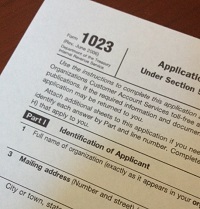The IRS recently released its beta version of the interactive Form 1023, the i1023, designed to make applying for tax exemption easier, and we took it for a test drive. Overall, the application is well organized, beginning with prompts to the user regarding an EIN, Articles of Incorporation and the requisite purpose and dissolution clauses. Certain sections generate a popup windows with specific tips and references to the instructions.
There are some good features of the interactive form. For example, the application automatically generates supplemental pages (typically what we prepare as a separate attachment) complete with entity name and EIN at the top of each page, and prompts the user to correct any spelling errors. In addition, if an answer is “no” and directs the applicant to the next section, the remaining boxes are no longer able to be checked—which can spare the user some confusion and time drain.
However, the IRS still has a few bugs to work out in the interactive form:
- A user can’t delete a section if answer changes from ‘yes’ to ‘no’ and supplemental information is not required;
- Part IX does not include space for 5 years of financial information in the data table, though the instructions for the interactive form reference a five-year period;
- Answering ‘no’ to Part X question 1a results in a popup directing the applicant to skip to Part XI when question 5 in Part X requires an answer for type of public charity status;
- Part X line 6 is appropriately grayed out to prevent the user from filling in obsolete information, though its continued inclusion in any form is potentially confusing; and
- The user fees are do not reflect the current amounts required to file.
Essentially, it is a more user-friendly version of the 2006 form, though it is somewhat disappointing that the IRS is electing to work off the old form (which contains some obsolete information) rather than making updates at the same time they make the form interactive. We are submitting feedback to the IRS, and encourage you to send your own comments to tege.eo.ceo@irs.gov. Please note that, as forewarned in the IRS release notice, the user is not allowed to print the document. On the bright side, we had the test form open for a relatively long period of time and the application did not time out.
In the interactive i1023 Acrobat file, the IRS also includes its top ten list (David Letterman-style) of tips to shorten the tax-exempt application process, which are worth sharing:
10. Provide the required information on the principal officers and board of directors. List the following information for the principal officers and board of directors: a) Names; b) Mailing addresses; c) Titles and Positions; d) Annual compensation.
9. Ensure a director, trustee, principal officer or other authorized individual signs the Form 1023. Generally, a principal officer is the president, vice president, secretary or treasurer. The person signing the application must indicate his or her title or other authority to sign. A taxpayer’s representative may not sign the application. An original signature is required. Neither a stamped signature nor a faxed signature is permitted.
8. Don’t forget to submit a copy of adopted bylaws, code of regulations or any other document that sets out the organization’s rules of operation, but only if adopted.
7. Include all of the necessary financial data. See the instructions to Form 1023 to determine how much information you need to provide, based on how long your organization has existed.
6. Include the month the organization’s annual accounting period ends. The accounting period ending date on the application should match the date stated in your by-laws, on financial statements, and on any prior returns filed.
5. Attach all required schedules. Some lines require supporting schedules. Check all line items on financial statements.
4. Complete all required pages. The information contained on each page and schedule of Form 1023 and Form 1024 is necessary for the IRS to make a determination about your tax-exempt status. Form 1023 has various schedules and pages that must be filled out for churches, schools, hospitals, scholarships, supporting organizations and certain other organizations.
3. Provide enough information about the organization’s activities to show us how it will achieve the exempt purpose. Please don’t restate the purpose. Explain the specific activities that will achieve that purpose. Consider a “who, what, when, where, why and how” approach. Explain past, present, and planned activities. If you haven’t started activity yet, develop plans that provide a clear understanding of how your organization will operate. It is not necessary to describe activities that are speculative at this time.
2. Attach a complete copy of the organizing document and all amendments. If the applicant is a corporation, include a complete copy of the articles of incorporation that shows it has been filed with and approved by the state. If the applicant is not incorporated, include a similar organizing document such as a constitution, articles of association, or by-laws. At a minimum, it should state the legal name, the purposes and the date of adoption. At least two members of the organization should sign the document. A trust document must be signed by the trustees and show the date of formation. For section 501(c)(3) applicants, the organizing document must comply with the organizational test for exemption.
1. The Number 1 tip to reduce delays in processing exempt organization applications is . . .
INCLUDE THE CORRECT USER FEE!
Ensure the application includes a check or money order made payable to the United States Treasury for the appropriate user fee.
We’ll keep on top of any further developments with this interactive form, and will share such information on this blog.


